Steel Products
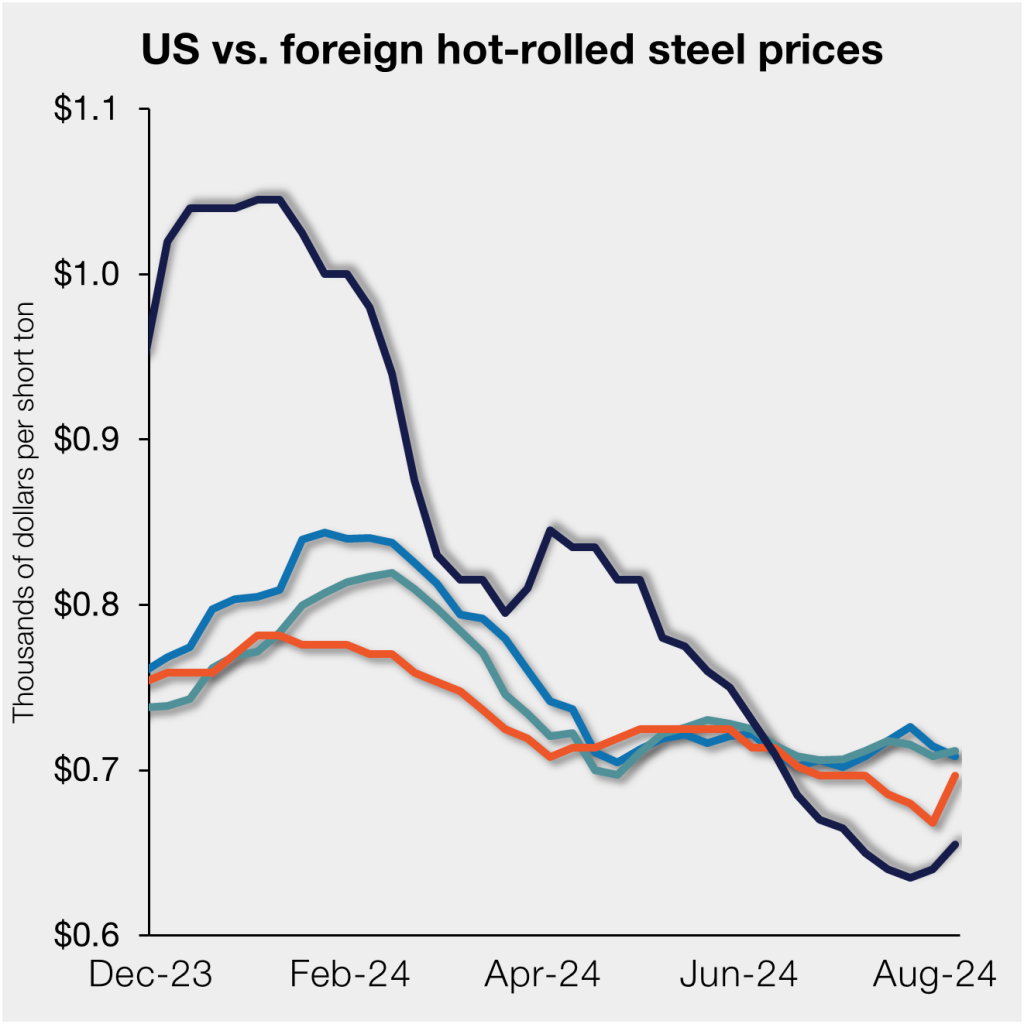
US HR remains cheaper than imports despite recent price gains
Written by David Schollaert
August 8, 2024
US hot-rolled (HR) coil remains cheaper than offshore material on a landed basis despite domestic tags inflecting upward lately.
But the spread between domestic and foreign HR has tightened on the heels of price hikes by US mill over the past two weeks. (Visit SMU’s price increase calendar to keep track of the latest mill price announcements).
SMU’s check of the market on Tuesday, Aug. 6, put domestic HR tags at $655 per short ton (st) on average, up $15/st from last week. Stateside hot band – still just $20/st from a 20-month low – remains $190/st below a recent high of $845/st in early April.
Domestic HR prices are now theoretically 7.8% cheaper than imports. They were 8.9% cheaper last week.
In dollar-per-ton terms, US HR is now, on average, $51/st cheaper than offshore product (Figure 1). That compares to $57/st cheaper on average last week. That’s a huge change from late last year, when US HR was hundreds often dollars more than offshore material.
The charts below compare HR prices in the US, Germany, Italy, and Asia. The left-hand side highlights prices over the last two years. The right-hand side zooms in to show more recent trends.
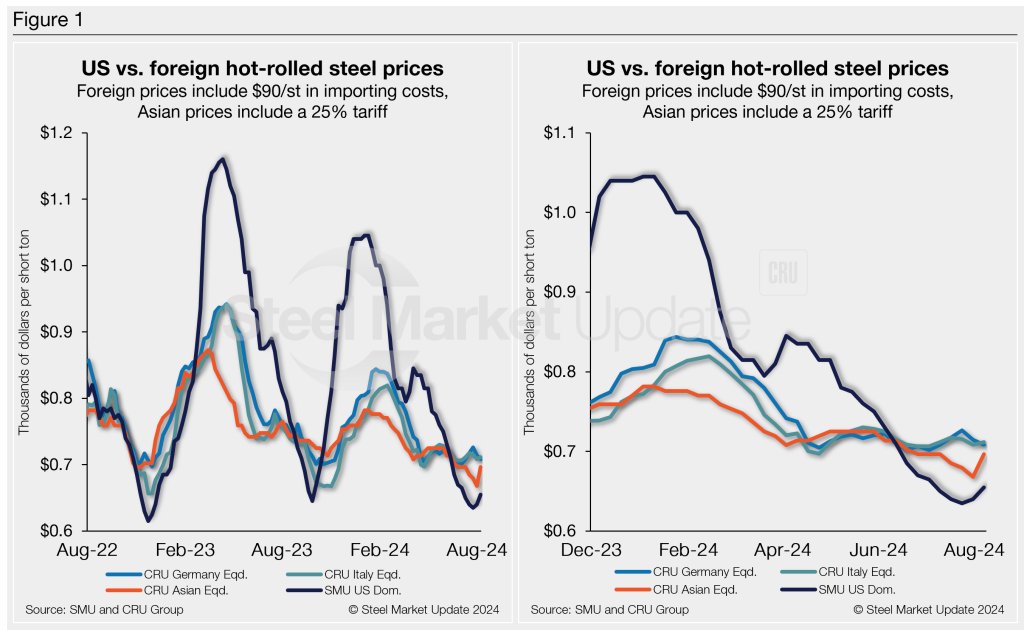
Methodology
This is how SMU calculates the theoretical spread between domestic HR coil prices (FOB domestic mills) and foreign HR coil prices (delivered to US ports): We compare SMU’s US HR coil weekly index to the CRU HR coil weekly indices for Germany, Italy, and East and Southeast Asian ports. This is only a theoretical calculation. Import costs can vary greatly, influencing the true market spread.
We add $90/st to all foreign prices as a rough means of accounting for freight costs, handling, and trader margin. This gives us an approximate CIF US ports price to compare to the SMU domestic HR coil price. Buyers should use our $90/st figure as a benchmark and adjust up or down based on their own shipping and handling costs. If you import steel and want to share your thoughts on these costs, please get in touch with the author at david@steelmarketupdate.com.
Asian HRC (East and Southeast Asian ports)
As of Thursday, Aug. 8, the CRU Asian HRC price was $485/st, up $22/st vs. the week prior. Adding a 25% tariff and $90/st in estimated import costs, the delivered price of Asian HRC to the US is approximately $697/st. This contrasts to the latest SMU HR average of $655/st for domestic material.
The result: US-produced HRC is theoretically $42/st cheaper than steel imported from Asia. That is down $14/st vs. last week. In late December, in contrast, US HR was $281/st more expensive than Asian product.
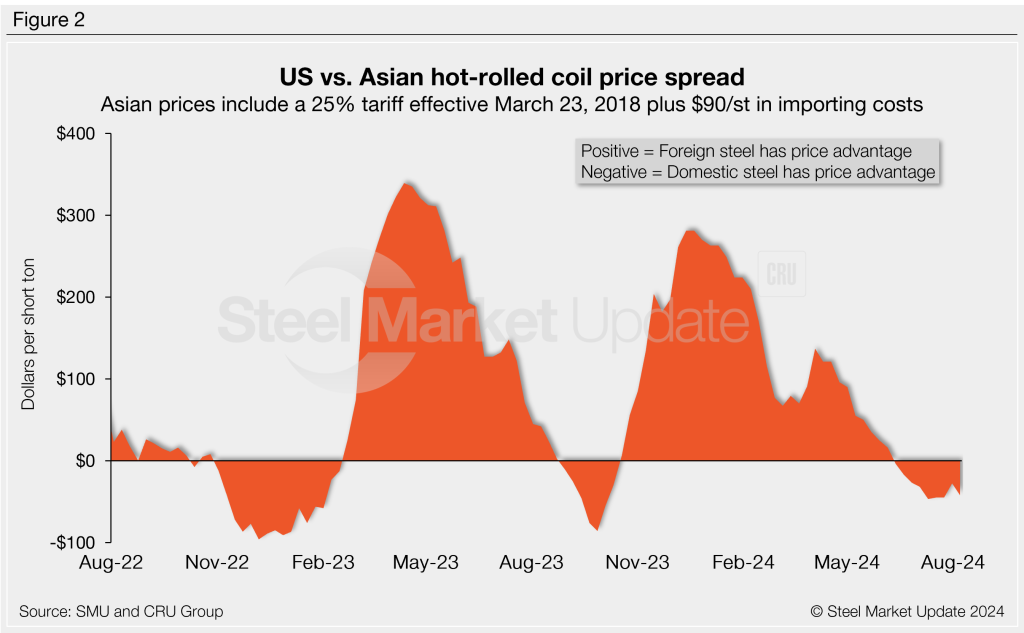
Italian HRC
Italian HR coil prices were up $3/st to roughly $622/st this week. After adding import costs, the delivered price of Italian HR coil is, in theory, $712/st.
That means domestic HR coil is theoretically $57/st cheaper than HR coil imported from Italy. That is down $12/st from last week. Just five months ago, US HR was $297/st more expensive than Italian hot band.
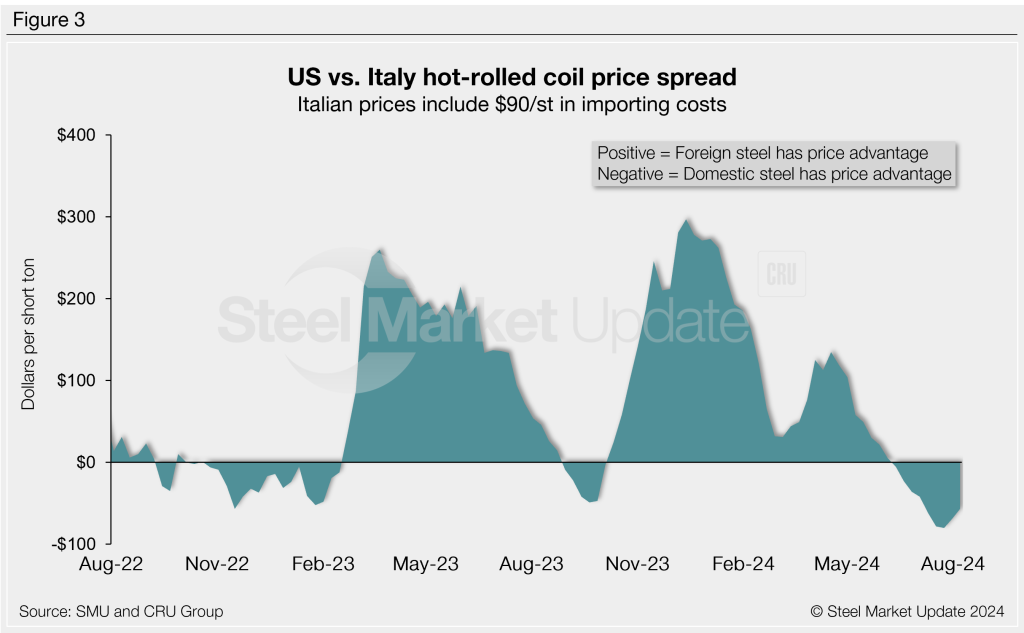
German HRC
CRU’s German HR price moved to $619/st, which is $5/st lower from last week. After adding import costs, the delivered price of German HR coil is, in theory, $709/st.
The result: Domestic HR is theoretically $54/st cheaper than coil imported from Germany, down from a $74/st discount last week. At points in 2023, in contrast, US HR was as much as $265/st more expensive than German hot band.
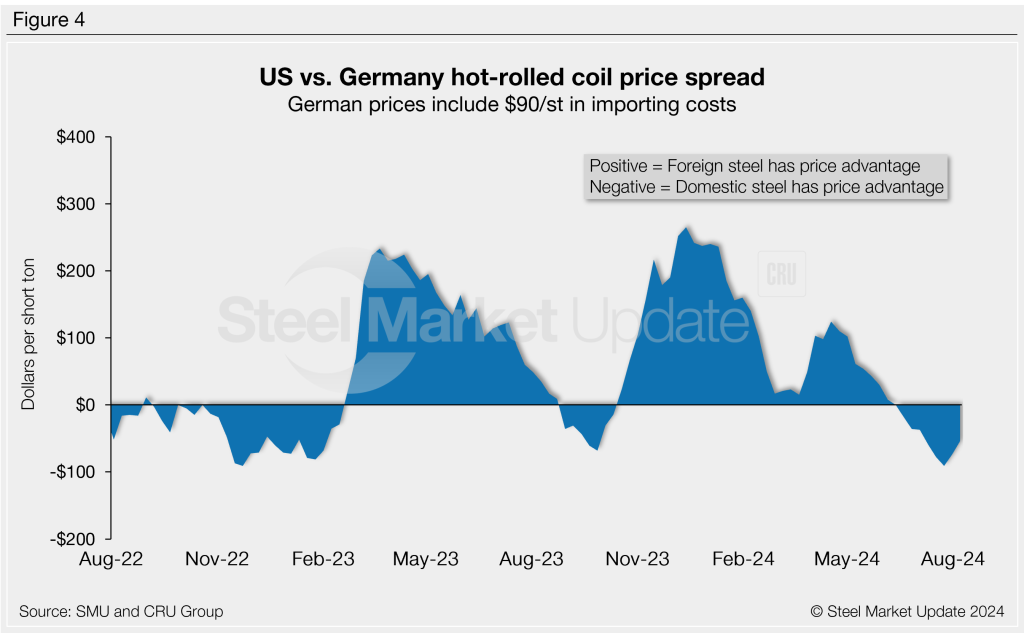
Notes: Freight is important when deciding whether to import foreign steel or buy from a domestic mill. Domestic prices are referenced as FOB the producing mill, while foreign prices are CIF the port (Houston, NOLA, Savannah, Los Angeles, Camden, etc.). Inland freight, from either a domestic mill or from the port, can dramatically impact the competitiveness of both domestic and foreign steel. It’s also important to factor in lead times. In most markets, domestic steel will deliver more quickly than foreign steel. Effective Jan. 1, 2022, Section 232 tariffs no longer apply to most imports from the European Union. It has been replaced by a tariff rate quota (TRQ). Therefore, the German and Italian price comparisons in this analysis no longer include a 25% tariff. SMU still includes the 25% Section 232 tariff on prices from other countries. We do not include any antidumping (AD) or countervailing duties (CVD) in this analysis.

David Schollaert
Read more from David SchollaertLatest in Steel Products
CRU: Excessive global supply could hit rebar mill investments in US
Following the onset of the war in Ukraine in March 2022, concerns about import availability and expectations of rising demand from President Biden’s Infrastructure Bill pushed US rebar prices to record highs. In response, a flurry of new mills and capacity expansions were announced to meet the rise in demand from growth in the construction […]

Steel buyer spirits tempered by soft spot market conditions
Steel sheet buyers report feeling bogged down by the ongoing stresses of stagnant demand, news fatigue, tariff negotiations or implementation timelines, and persistent macroeconomic uncertainty.

CRU: US stainless prices to rise on expanded S232 tariffs
Stainless prices in the US market will rise, following price increases by major US producers. Our base case scenario incorporates higher US prices in the near term, despite the initial negative reaction by the market. US stainless prices will go up in 2025 H2 and will stay elevated in 2026 as tariffs on stainless […]
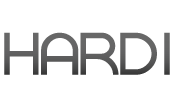
Galvanized steel demand unsteady amid lingering buyer fatigue: HARDI
Uneven demand for galvanized steel in June reflects a market that remains mired in uncertainty, according to industry sources.

OCTG industry salutes Customs for catching trade crooks
The US OCTG Manufacturers Association is commending US Customs for intercepting another Thai company's attempt to illegally transship Chinese oil pipe to the US.
